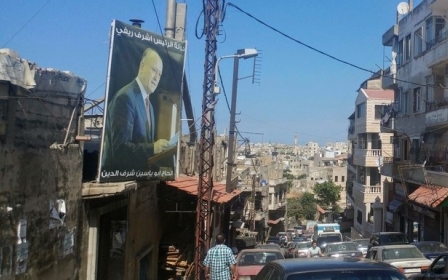Who wins from casting Hezbollah as a new terror bogeyman?

On 10 October, the United States announced multimillion-dollar rewards for "information leading to the location, arrest, or conviction in any country" of Talal Hamiyah and Fu'ad Shukr, said to be "key leaders" of Lebanon's Hezbollah. The bounty for Hamiyah has been set at "up to $7 million"; for Shukr, it’s merely "up to $5 million".
In the accompanying US State Department press briefing on "US efforts to counter Hezbollah", ambassador-at-large and coordinator for counterterrorism, Nathan Sales, and National Counterterrorism Center director Nicholas Rasmussen competed to see who could emit the most words without saying anything of substance.
Hezbollah's raison d'etre
A couple of takeaways: despite pretending to be a political party in Lebanon, Hezbollah is a "terrorist organisation" that is "rotten to its core", with a decades-long "penchant for violence". Created by Iran to "foment instability… across the world", it is currently "determined to give itself a potential homeland option as a critical component of its terrorism playbook" (translation: Hezbollah is plotting attacks on the US). "[O]ur work related to Hezbollah is every bit as much of a priority as our work against al-Qaeda and ISIS."
And of course, no discussion of the Lebanese group would be possible without trotting out this pet factoid: "Prior to September 11th… Hezbollah was responsible for the terrorism-related deaths of more US citizens than any other foreign terrorist organization"- namely via the 1983 bombing of the US embassy in Beirut and the "even more deadly attack on our [Beirut] Marine barracks in October of 1983 which killed 241 Americans."
For the current [US] administration’s intensified anti-Hezbollah campaign, a pliant mainstream media can be forever counted on to fuel the spectre of the terror-bogeyman
Leaving aside the fact that Hezbollah didn't officially exist in 1983, the enduring hype over the barracks bombing fails to account for the detail that the Marines are by definition a military force - and as such were perceived as occupiers by certain sectors of the Lebanese population.
More important, however, is that 1983 was one year after a 1982 US-backed Israeli invasion that killed some 20,000 people in Lebanon, primarily civilians - and that ultimately served as Hezbollah's very raison d'être.
Also in 1982, the Israelis had orchestrated a three-day massacre of up to several thousand people in Beirut’s Palestinian refugee camps of Sabra and Shatila.
Homeland insecurity
On its website, the US State Department explains that the "Rewards for Justice" programme now targeting the two Hezbollah figures has since its launch in 1984 "paid in excess of $145m" to individuals who have "provided actionable information that helped bring terrorists to justice or prevented acts of international terrorism worldwide."
(Obviously, US government penny-pinching should only be applied to frivolous pursuits like healthcare and education - and forget about "justice" for victims of US drone strikes in Pakistan or US-backed death squads in Latin America.)
According to Ambassador Sales' logic, the Iranian and Lebanese people have all suffered terribly on account of "Iran and Hezbollah's deadly partnership" - although the US has certainly helped ease their pain by, inter alia, rush-shipping bombs to the Israeli army as the latter devastated swathes of Lebanon in 2006, killing some 1,200 people.
In Tehran in 2015, I had the opportunity to speak with Iranian victims of deadliness, including Shohreh Pirani, the widow of Dariush Rezaeinejad, an academic and deputy at the Atomic Energy Organisation of Iran who was shot dead in 2011 at the age of 35 - apparently with Israeli assistance. Pirani had witnessed the murder along with the couple’s young daughter, who was also present at our meeting and who selected family photographs to show me on her mother’s cell phone.
To be sure, it’s no coincidence that the present ruckus over the Hamiyah-Shukr duo and the direct threat Hezbollah supposedly poses to the US homeland happens to be occurring in tandem with US President Donald Trump’s efforts to obliterate the possibility of sane coexistence with Iran (not to mention the rest of the world).
This is, of course, not the first time the Iran-Hezbollah menace has been forcibly brought closer to home; for years, breathlessly ludicrous reports have emerged concerning Hezbollah’s alleged contributions to narco-tunnels under the US border and the alleged proliferation of Farsi tattoos among imprisoned gang members in the American southwest.
And luckily for the current administration’s intensified anti-Hezbollah campaign, a pliant mainstream media can be forever counted on to fuel the spectre of the terror-bogeyman.
Fake interviews
The bid to delegitimise Hezbollah is additionally facilitated by a certain cohort of journalists - writing for The Daily Beast, Newsweek, The Nation and so on - who somehow possess magical access to otherwise super-secretive Hezbollah commanders and militants, from whom they are able to extract convenient sound bites like: "We have no intention of giving up most of the territories we control in Syria."
Lebanese scholar Amal Saad, author of Hezbollah: Politics and Religion and a forthcoming title from Palgrave Macmillan on the party's transformation from national resistance into regional power, has remarked numerous times on how funny it is that she - a trusted academic with solid knowledge of Hezbollah - is made to jump through a spectacular series of hoops to obtain authorisation for interviews, while envoys from the West can just waltz in.
Casting Hezbollah as 'a genuine threat to US security' distracts 'attention and resources… away from the real threat posed by ISIS and its funders, not only to the US, but the world at large'
– Amal Saad, author of Hezbollah: Politics and Religion
Saad mentioned - in a recent conversation - that one of the problems with these "fake interviews", as she calls them, is that they "provide dangerous ammunition to hawkish policymakers like the Trump team in its ever-escalating bid to equate a grassroots resistance movement like Hezbollah with the ISIS/al-Qaeda death cults."
Saad said that casting Hezbollah as "a genuine threat to US security" distracts "attention and resources… away from the real threat posed by ISIS and its funders, not only to the US, but the world at large."
Fortunately for the global arms industry, both real and fabricated threats trigger significant flows of capital. And as long as Hezbollah and Iran are seen as threatening US-Israeli designs on the Middle East, they’ll be combated at all costs.
It remains to be seen whether any new multimillionaires are set to debut on the world stage thanks to the State Department's "Rewards for Justice" terror-tattle programme - but it's long been clear that, in the world as currently configured, justice is rarely rewarded.
- Belen Fernandez is the author of The Imperial Messenger: Thomas Friedman at Work, published by Verso. She is a contributing editor at Jacobin magazine.
The views expressed in this article belong to the author and do not necessarily reflect the editorial policy of Middle East Eye.
Photo: Supporters of Lebanon's Hezbollah leader Sayyed Hassan Nasrallah display Hezbollah and Lebanese flags in Baalbek, Bekaa valley in eastern Lebanon, 31 August 2017
New MEE newsletter: Jerusalem Dispatch
Sign up to get the latest insights and analysis on Israel-Palestine, alongside Turkey Unpacked and other MEE newsletters
Middle East Eye delivers independent and unrivalled coverage and analysis of the Middle East, North Africa and beyond. To learn more about republishing this content and the associated fees, please fill out this form. More about MEE can be found here.






